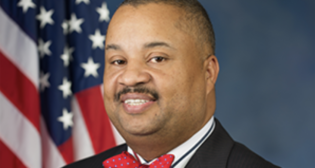
NTSB Investigation of Amtrak Southwest Chief Derailment Under Way, BNSF Track Opens, Lawsuits Filed (UPDATED July 1)
Written by Railway Age Staff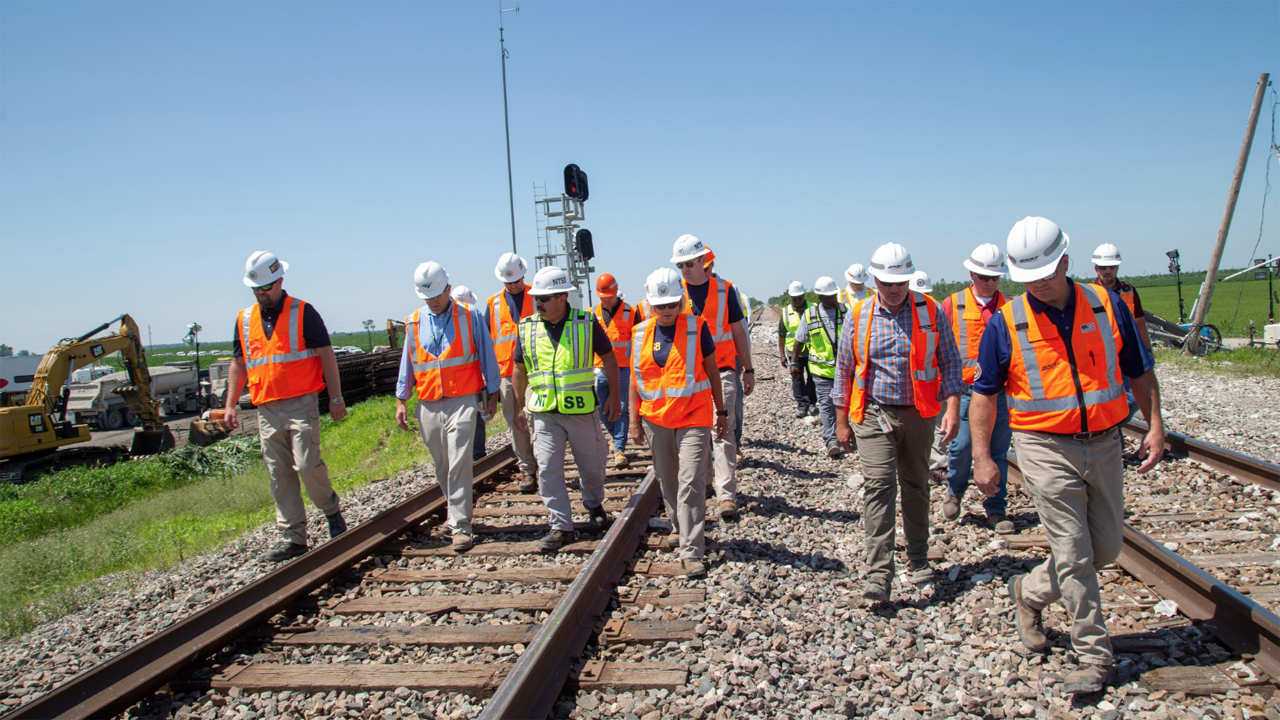
NTSB Chair Homendy and NTSB investigators, along with investigation party members, walk the accident scene of the June 27 grade crossing collision and derailment between an Amtrak passenger train and dump truck near Mendon, Mo. (Photograph and Caption Courtesy of NTSB, via Twitter, June 29)
Amtrak’s Southwest Chief train 4 traveling eastbound from Los Angeles to Chicago on June 27 derailed after striking a dump truck that was obstructing a public grade crossing in Missouri.
Three train passengers—sisters Rachelle Cook, 58 and Kim Holsapple, 56; and Bihn Phan, 82—and the truck driver died as a result of the accident; 150 people were taken to 10 area hospitals for treatment of injuries ranging “from minor to serious in nature,” the Missouri State Highway Patrol reported. National Transportation Safety Board (NTSB) Chair Jennifer Homendy in a June 28 media briefing said the agency was focused on the grade crossing, the approach to the grade crossing and survivability after an accident.
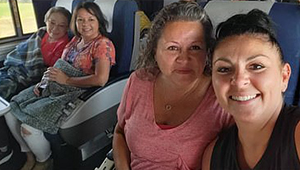
Two locomotives and eight cars derailed at 12:43 p.m. CT, following the collision at a passive crossing, which included a stop sign and crossbucks. The site, on Porche Prairie Avenue in Chariton Country, is southwest of Mendon, Mo., and some 80 miles northeast of Kansas City, Mo.
In a media briefing on June 29, Homendy reported that train 4 was traveling at 89 mph “when the horn blew, which was a quarter-mile out from the crossing,” and at 87 mph at the time of impact. The area speed limit: 90 mph.
The train was running on BNSF Transcon track and carrying approximately 275 passengers and 12 crew members. The truck, a 2007 Kenworth driven by Billy Barton II, 54, of MS Contracting, was transporting aggregate to an Army Corps of Engineers levee project just north of the crossing, according to NTSB.
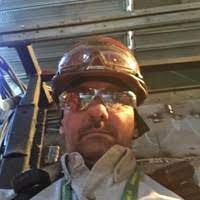
Homendy told the media on June 29 that there is a “very steep” approach to the crossing, and that NTSB would be looking at the crossing profile and surface, as well as sight distance, for instance. She pointed out that “[t]here’s a lot resting on a driver to be able to see a train at these crossings, particularly when there’s such a steep incline. You have to look for the train. You have to worry, ‘Am I going to get up? Am I going to stall out? Am I going to get over?’ Then you’re worrying about any obstructions on the vehicle itself, sight distance from any sort of vegetation, so there’s a lot that goes on there. So, we’re going to be able to determine more as we get through tomorrow and the weeks ahead.”
Additionally, Homendy said she spoke with an area farmer who had complained about the crossing in the past, and with the County Commissioner who received complaints from community members on such issues as the steepness of the crossing, navigating the crossing in general, and sight distance.
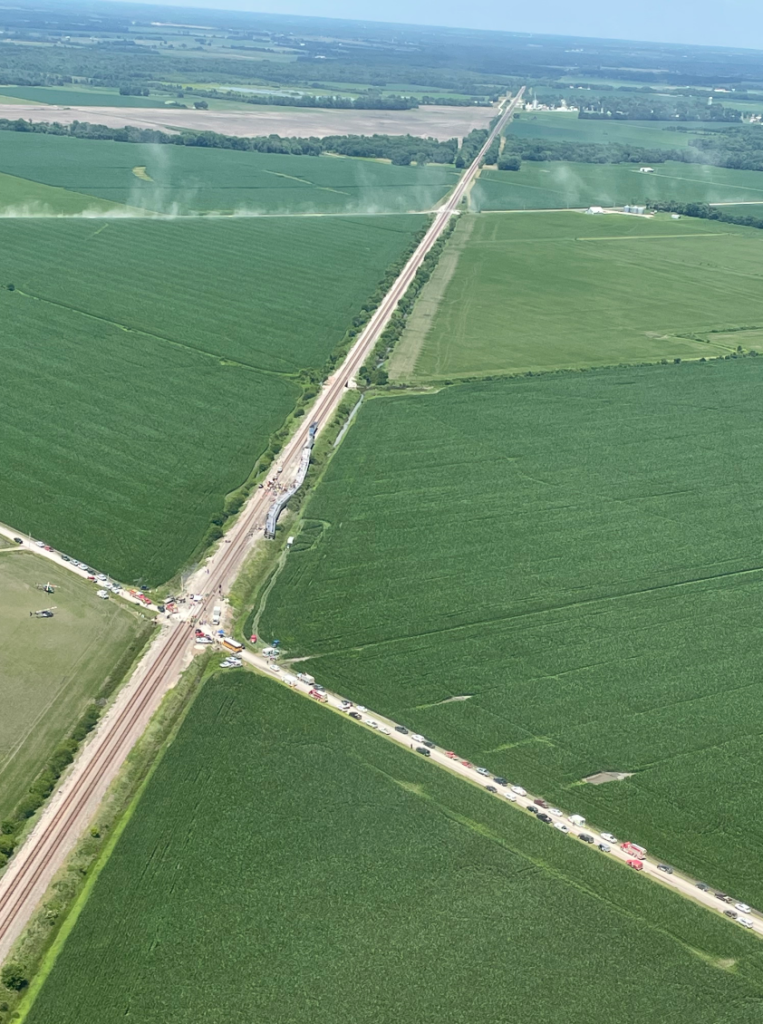
Homendy also told media that that NTSB does “not have concerns about [train] mechanical issues. We tested the brakes; there are no concerns with the brakes.” The agency is looking at crashworthiness, however. “Lives were lost on the train so we’re looking at survive-ability,” she said. “We’re looking at seating configurations; some of the seats move and rotate. … We’ve made recommendations on this in the DuPont, Washington, accident that we investigated involving an Amtrak train, where the seats weren’t locked and the seats swiveled—that has an impact on survive-ability. We’re also looking at lighting, handles, windows, doors. On the windows, we’re going to look at ejection or popping of the windows. We can say there were no passenger ejections in this accident, but when a window is ejected, and the train is on its side, and sliding on its side, ballast, gravel is coming into the train, into that train car, and that has an impact. So we’ve had recommendations on windows popping out or popping in for decades, so that’s something we’re going to look at as part of this investigation. Now I’m really happy that FRA had Volpe out here, which does a lot of its research and engineering also on passenger windows, so they were looking at that too as we were going through the railcars, which was really helpful. Again, our goal is to make sure that people can walk away if there is an accident.”
“An investigation, from my standpoint, is really just the first step,” Homendy summed up on June 29. “I’ve said this many times: Safety isn’t improved until the lessons learned from a tragedy are addressed. And if there are concerns with this crossing, and we have significant concerns. We also have concerns about making sure that people are able to survive an accident when it does occur, after a terrible tragedy, particularly those in the railcars. Action needs to be taken so another accident doesn’t occur, another death doesn’t occur, another serious injury doesn’t occur. It’s imperative that we take action. I know that there are a lot of crossings, and there are 2,200 grade crossing collisions in the United States annually. This is the one I’m focused on right now, and we can do something about it. The NTSB can only do an investigation. We don’t do funding, we don’t do regulation, but we’ve got a big voice and it’s important that we take this time to honor those that lost their lives and the serious injuries and make some change, make some improvements. We know there need to be some improvements. And I’m going to see what we can do. I spoke with the Administrator of the Federal Railroad Administration, the Acting Administrator of Federal Highways. I have their commitment to work with me. I’m hopeful I have the commitment from others on the state level, and with Amtrak and with BNSF. But we can take action. We can do it. And I’m going to see if we can take those next steps and where we can go from here.”
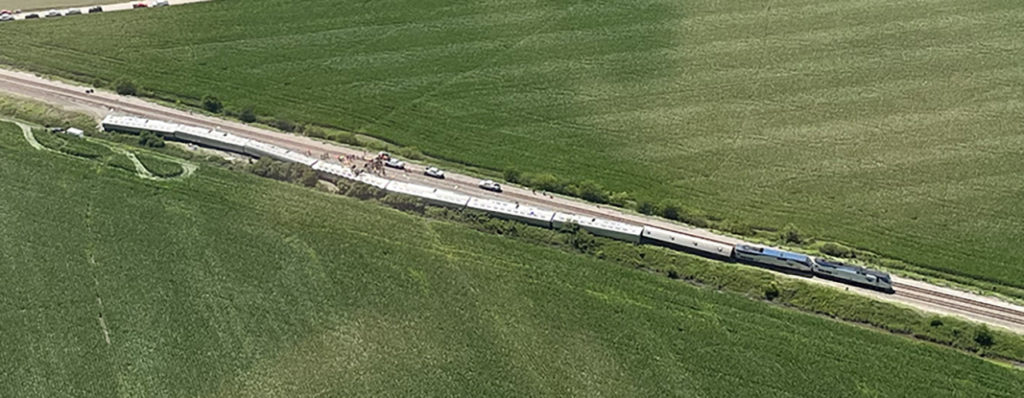
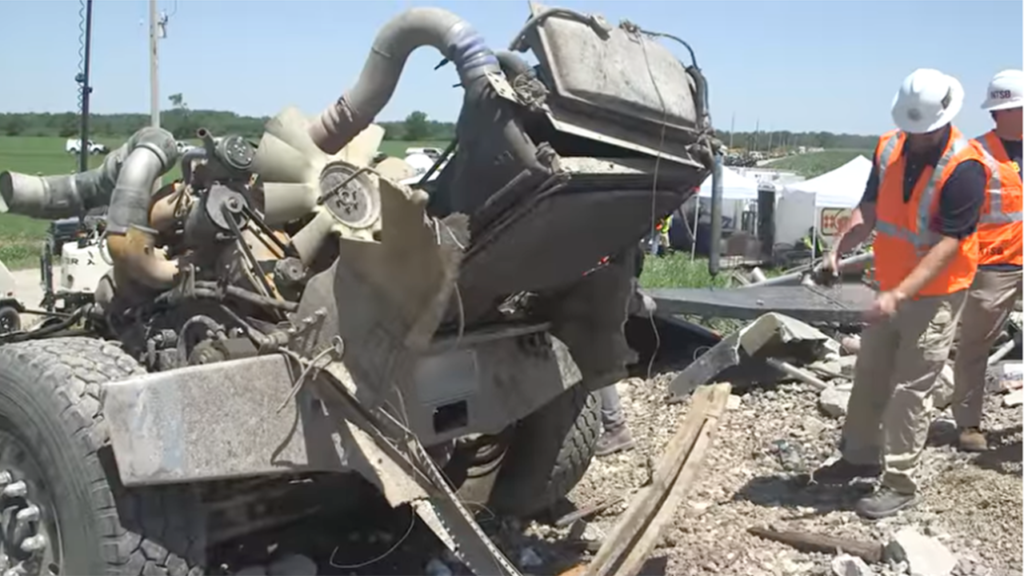
The NTSB dispatched a 16-member “go-team” to investigate the derailment. The Federal Railroad Administration (FRA) also dispatched personnel to the scene. The agency told Railway Age on June 28 that its “multi-disciplinary team is investigating the accident alongside and in support of the National Transportation Safety Board.” FRA Deputy Administrator Jennifer Mitchell and Associate Administrator/Chief Safety Officer Karl Alexy are also on-site. Other parties to the investigation are BNSF, Amtrak, Missouri Department of Transportation, Missouri State Highway Patrol, MS Contracting LLC (the trucking company), SMART and BLET. In two weeks, NTSB is slated to release a preliminary report that includes factual information, not analysis.
The accident site was on a list of grade crossings recommended for safety upgrades, the Kansas City Star reported. A February report, part of the Missouri State Freight and Rail Plan, recommended warning lights and crossing gates for Porche Prairie Avenue, at an estimated cost of $400,000. Nearly half of the approximately 3,800 grade crossings in Missouri are unprotected, the state Department of Transportation said.
BNSF Track Opens to Traffic
In a June 30 statement, BNSF spokesperson Lena Kent told Railway Age that “[b]oth main lines on a portion of our Southern Transcon in northern Missouri are back in service following the Monday afternoon [June 27] derailment of an Amtrak train. … The first main track was restored within 12 hours under speed restriction, while the second main at the affected location reopened to traffic yesterday evening [June 29].” She reported that the Class I railroad “continues to work closely with Amtrak, the National Transportation Safety Board, and other officials to investigate this incident.”
“In terms of additional warning devices,” Kent said, “BNSF, as you may know, does not determine what measures are placed at [a] public crossing. The first step is for the MODOT [Missouri Department of Transportation] to set up a diagnostic review of the crossing. Once that has been completed and the recommended approach is established, we would work with the various parties to implement any changes.” She added that MODOT “would set up the diagnostic meeting to determine if the crossing could be closed/consolidated or if any additional warning devices are warranted. If it is determined that additional warning devices are recommended, the equipment would need to be designed, built and installed. The County would be responsible for the approaches.”
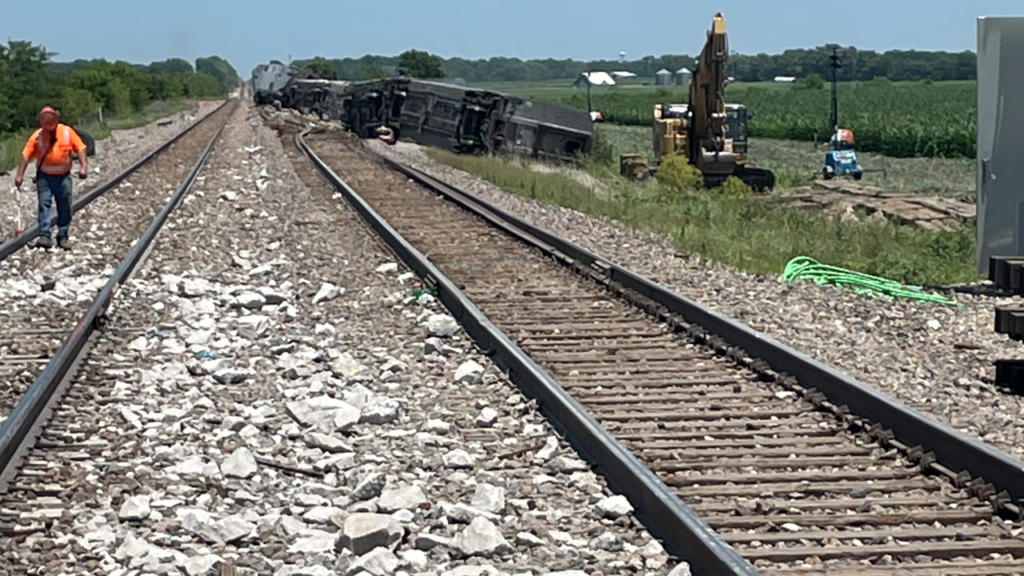
Amtrak Response, June 28
Amtrak said in statement released at 2:14 p.m. ET on June 28: “We are deeply saddened to learn that the Missouri State Highway Patrol is now confirming that four people, three passengers [including one who died at University Hospital, according to the Missouri State Highway Patrol] and the truck driver, have lost their lives as a result of this grade crossing incident. There are also several reported injuries among the passengers and crew members traveling on the train. Amtrak is working with local authorities to make sure those who are injured get medical care and everyone else receives services and transportation. We are grateful for the support from the local authorities who provided assistance and resources for our customers and employees. The National Transportation Safety Board (NTSB) has activated, and we will fully support the NTSB with its investigation. Additional details will be provided as available.”
Amtrak also reported that passengers who were traveling onboard train 4, which departed Los Angeles, Calif., on Sunday, June 26, “are being re-accommodated as quickly as possible on other trains or buses as available. Additionally, Southwest Chief train 4, which departed L.A. (LAX) on Monday, June 27, will terminate in Kansas City, Missouri (KCY). Southwest Chief train 3, scheduled to depart Chicago (CHI) on Tuesday, June 28 will originate in KCY. Southwest Chief train 3, scheduled to depart CHI on Wednesday, June 29, will originate in KCY. Southwest Chief train 4, schedule to depart LAX on Wednesday, June 29 is cancelled.”
“We are deeply saddened by yesterday’s [June 27] tragic event and mourn those who lost their lives,” Amtrak CEO Stephen Gardner said in a separate June 28 statement. “For those who helped others, we want to express our heartfelt appreciation. This includes our hard-working frontline team members, numerous local authorities and emergency personnel who quickly mobilized to help all at the scene, and our customers, including a group of Boy Scouts onboard who jumped in to help others.
“We are committed to cooperating fully with the National Transportation Safety Board (NTSB), the Federal Railroad Administration (FRA), local law enforcement, response agencies, and all the other organizations with an official role in the investigation and response and that share our urgency to do everything we can to prevent future accidents. This incident is a critical reminder about the importance of exercising extreme caution around railroad tracks and crossings. As the NTSB works hard to investigate this incident, we remain committed to helping our passengers, crew, and the families of those who were affected in any way. In addition to myself and other Amtrak leadership, our Incident Response Team is here in Mendon to offer our support in every way that we can. A Family Assistance Center has been established to address the needs of our passengers, their families and loved ones. To support those who have been hospitalized, nurse case managers will be available on site.
“We are indebted to and thank the first responders, hospital staff and law enforcement for their immediate and ongoing help. This includes the Red Cross, Missouri State Highway Patrol, Missouri Department of Conservation, Missouri State Park Rangers, Missouri State Fire Marshals, and the Missouri State Emergency Management Agency; law enforcement from Chariton, Linn, Macon and the Randolph County Sheriff’s Office; the Brookfield and Macon police departments; and emergency management services from Chariton, Linn, Randolph, Livingston, Macon, Howard, Carroll and Caldwell counties. We also thank Northwestern High School here in Mendon for providing shelter for our customers and the community members who brought food to the school and transported passengers to the hospitals—this is a special community, and we thank you for all you have done.
“We also want to extend thanks to the FRA for assisting with the response, investigation and continuously working to improve rail safety, along with BNSF, the track owner, for quickly mobilizing to assist with the emergency response and recovery of the route.
“Please join us in continuing to keep everyone impacted by yesterday’s events in your thoughts.”
U.S. Department of Transportation Secretary Pete Buttigieg on June 27 spoke out about the accident on Twitter: “Saddened by the tragic loss of life and injuries in the Missouri train derailment today & Northern California collision over the weekend. I have been kept updated & my team is in touch with Amtrak & relevant authorities. …”
On June 26, an Amtrak train collided with a car crossing the tracks in Contra Coast County, Calif., according to the Los Angeles Times, which reported that three died and two were injured, all in the car that was struck.
NTSB Media Briefing, June 28
NTSB Chair Jennifer Homendy held a media briefing, plus Q&A, at 4 p.m. CT on June 28. Railway Age provides a transcript, edited lightly for length and clarity, below. (Scroll down to watch the briefing video.)
“… Our mission is to determine what happened, why it happened, to prevent reoccurrence of that incident in the future. Before I go on, I do want to say on behalf of the National Transportation Safety Board, to the families of those who lost loved ones in this tragedy, we extend our deepest condolences. And the survivors who continue to face challenges over the next several months or years, whether it’s physical or mental pain and anguish, we will think of you in the weeks, days and months to come.
“At 12:43 p.m. local time yesterday, June 27, Amtrak train 4 was traveling east on the Southwest Chief, which is their long-distance line from Los Angeles to Chicago. At the same time, a truck that is owned and operated by MS Contracting LLC, based in Brookfield, Missouri, was transporting aggregate to an Army Corps of Engineers project, just north of the crossing. The truck traversed the crossing and came into the path of Amtrak train 4. The train struck the back part of the truck, and then the train derailed. The train consisted of two locomotives, six coach cars, a café car and a baggage car, and again, all derailed.
“This is our first full-day on scene, so we are gathering a lot of information at this time. I’m going to give you an idea of some of that information. First of all, we are downloading the event recorder. That event recorder is going to give us information on when the locomotive engineer blew the horn. It’s going to give us information on the speed of the train. In this area, the speed limit is 90 mph. It’s going to give us information on the brake application, whether it was full-service brake application or emergency braking. We’re also downloading the two forward-facing cameras. There was not an inward-facing camera, but there are two forward-facing cameras. There’s also an electronic-control module on the truck, the road vehicle, that we’re going to want to take and look at and see if it’s damaged and see if we can download similar information from that vehicle. We’re downloading data from the wayside signal systems.
“And we began interviews of the crew. There were 12 crew members on board the train, so we do want to talk with them and that is continuing. … In addition, we have two members from our Transportation Disaster Assistance Team who are working with the families. Victims were transported to 10 different hospitals, so our Disaster Assistance Team will go to the hospitals and meet with survivors and families of victims. They will also go to the Family Assistance Center in Columbia [Missouri] and work with the Red Cross.
“We’ll then have an organizational meeting tomorrow morning where we will determine what our next steps are. I know I’m going to get questions on the numbers of injuries and the number of fatalities. I’ve seen and heard a lot of numbers today. And I’m not comfortable with releasing any information unless I’m exact on that information. So I’m going to defer injury and fatality numbers to the medical examiner.
“I do want to take a moment and thank our safety partners and those who are working with us on this investigation. And those include BNSF Railway; Amtrak; the Federal Railroad Administration; the Missouri Department of Transportation, who I spoke to today, [Director] Patrick McKenna was on scene; the Missouri State Highway Patrol; a number of local emergency responders that came when this tragedy occurred; and of course as I mentioned, our tremendous partnership with American Red Cross—thank you for all you do. I also want to take a moment, I haven’t had an opportunity to speak with the Troop leaders, but I understand that there were two Boy Scout Troops with leaders on the train: Boy Scout Troop 73 and 12 based in Appleton, Wisconsin. And I understand that they were providing assistance after the accident. And so I do plan to reach out to those Troops and thank them for those efforts.
“I do want to take a moment and talk about passive grade crossings. So this was a passive grade crossing. There are active crossings and passive crossings. What makes this a passive crossing is there was a stop sign and cross-bucks. There were no [gate] arms; there were no warning lights; there were no bells. Those are active crossings. In the United States, there are about 130,000 passive crossings. It’s about 50% of crossings in the U.S. In Missouri, there are 3,500 passive crossings; it’s about half of their crossings, as well. Fifty-three percent of grade crossing incidents in Missouri occur at passive crossings. And so the NTSB has issued recommendations for a number of years, on either closing crossings, consolidating crossings, separating grade crossings, and making grade crossings that are not separated or consolidated active crossings. So there are gates, bells, whistles to provide warnings to drivers who approach crossings. In addition, we have recommended since 1998, in 1998 we did a study on passive grade crossings and technology. And we made recommendations on technology in roadway vehicles that could alert drivers of a presence of a train on an approach to a grade crossing. We still don’t see action on that. It’s been 24 years, and that recommendation is still as important today as it was in 1998. Lives could be saved.”
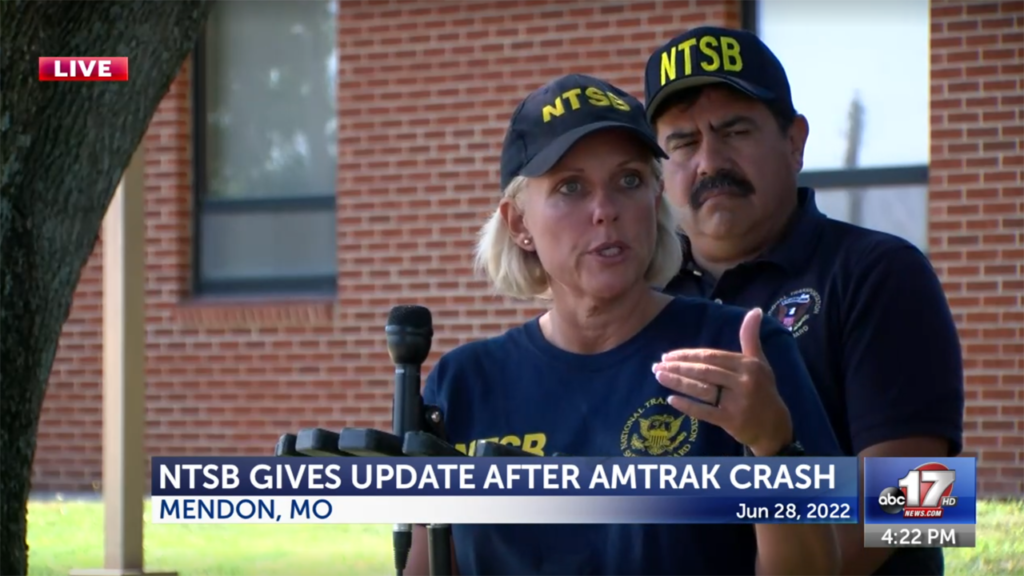
Homendy also took reporter questions. Among them:
• Is the NTSB aware of complaints about this particular crossing going back to 2019? “We will be aware,” Homendy said. “We have not been aware that there have been specific complaints about this crossing. However, today, I did ask the Missouri DOT Director if this crossing was one that was in a list of crossings that they wanted to upgrade. He did confirm that. For this crossing, I did ask how much it would cost to make this an active crossing, and the figures I was provided was about $400,000. But that is more information that we are going to see from the state and others.”
• Is Homendy angry with the state and others for not taking action on NTSB recommendations, for example? “Any time our recommendations aren’t heeded, of course, I’m upset because we see tragedy, after tragedy, after tragedy, and numerous fatalities and injuries,” Homendy said. “And we know, and it’s very frustrating for our investigators, very frustrating when they are on scene and they know that it would have prevented this. But, you know, at the same time my concern especially when we arrive on scene is just for the families and just how tragic this is. I mean, I love travel by train. I love to ride Amtrak. I’ve ridden Amtrak on the Empire Builder and numerous lines. It’s one of the safest forms of transportation—rail. And so it is so sad when a life is lost as a result of traveling a way that you love. So it’s heart-breaking, and I really feel for the families.”
• When will you know how fast the train was traveling? “I’m hoping we’ll have an answer for you on the speed the train was traveling tomorrow [June 29],” Homendy said. “I’ve been given some preliminary information, but I want to make sure the data is accurate. We want to make sure that the information that was put in on the size of the wheels produced the right information for the speed. And so we just want to confirm that, so I hope to have that to you tomorrow.”
• How confident are you that you’ll come up with a cause of this accident? “Very confident,” Homendy said. “How confident am I on the cause of the accident? You know, when we look at the cause, we don’t just look at the immediate contributing or causal factor, which in this case was a truck that went into the path of an Amtrak train. A train can take up to a mile to stop. It’s very difficult. And so, what do you do in a situation where a vehicle goes right in front of a train as it’s moving? I mean, the locomotive engineer reacted. But there are other contributing factors in any accident that we will look at, including lack of vehicle technology, lack of grade crossing infrastructure, and other things that could prevent a future incident from occurring.”
• Have seat belts on trains been considered? “We have actually looked at restraints in the past, in our DuPont, Washington, investigation, especially for children at the time,” Homendy said. “But certainly we have crashworthiness specialists that are on scene who will look at what occurred in the accident, and how someone could survive an accident that would occur in the future. And that will be part of our investigation and what we report on in our final report.”
• Who is responsible for making this crossing an active crossing? “In this case, this is a county road, and so there’s a partnership between the county; the state for funding; and, frankly, BNSF because it’s their railway,” Homendy said. “And so it really is the three entities working together that would be responsible for installing active warning devices at this crossing.”
• When was the train last inspected? Is NTSB worried about equipment failure? “We will request that information from Amtrak on the last inspection, and what that inspection produced,” Homendy said. “I do not have concerns about mechanical failure about the train, any mechanical issues with the train. We do not have concerns about track. Our concerns are very focused on this grade crossing, the approach to the grade crossing and survivability after an accident.”
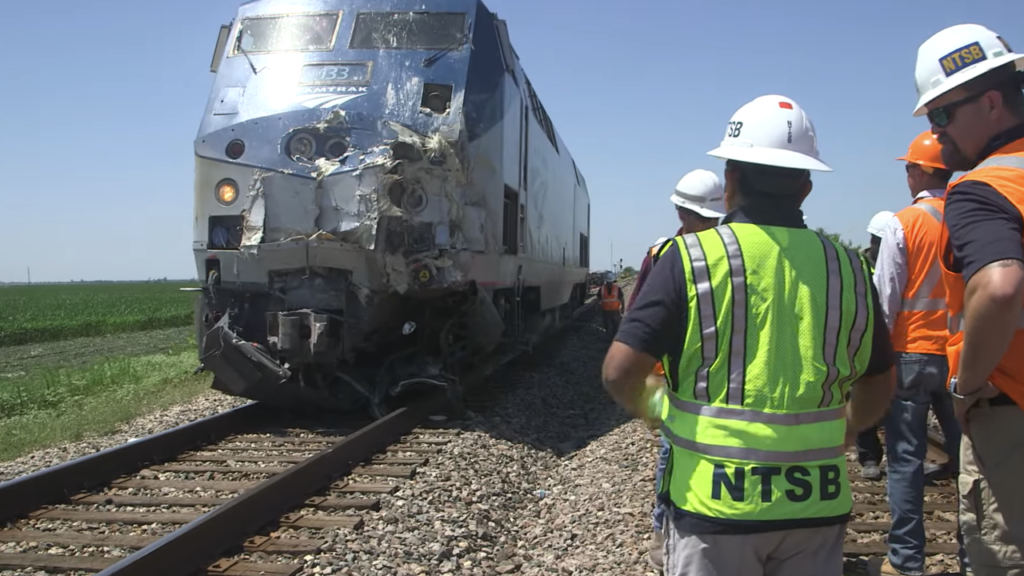
Lawsuits Filed
BNSF and Amtrak jointly filed a lawsuit (download below) in U.S. District Court for the Eastern Division of Missouri Northern Division in St. Louis against MS Contracting, which is based in Brookfield, Mo. The suit claims that Barton, the driver who died in the wreck, operated the truck in an “unsafe, careless and reckless” manner on behalf of MS Contracting, didn’t yield to the right-of-way to the Southwest Chief, and was using a cellphone, which distracted him. The lawsuit seeks unspecified damages, but contends that BNSF and Amtrak incurred damages totaling more than $75,000. Both companies also allege they incurred labor costs, suffered delays and disruptions and will be subject to other economic and financial loss due to the crash.
Amtrak and BNSF cited no fewer than 20 points of how “MS Contracting and its agents, officers, or employees were negligent, grossly negligent, and/or reckless”:
- failing to use the highest degree of care in the operation of the Dump Truck in violation of § 304.012 RSMo ;
- operating the Dump Truck in a careless and imprudent manner in violation of § 304.012 RSMo.;
- failing to stop at the railroad crossing in violation of a posted stop sign and § 304.351 RSMo.;
- failing to stop at the railroad crossing at a point between 15 and 50 feet of the nearest rail of the railroad track and not proceed until it was safe to do so in violation of § 304.035.1 RSMo;
- failing to stop at the railroad crossing at a point between 15 and 50 feet of the nearest rail of the railroad track despite the fact that Amtrak Train 4 was clearly visible and in hazardous proximity to the crossing;
- failing to stop at the railroad crossing at a point between 15 and 50 feet of the nearest rail of the railroad track despite the presence of traffic signs and/or, devices at the railroad crossing;
- operating the Dump truck through the railroad crossing without sufficient undercarriage clearance necessary to prevent the undercarriage of the vehicle from contacting the railroad crossing in violation of § 304.035.4 RSMo;
- operating the Dump Truck, a commercial motor vehicle, at a rate of speed which did not permit the Dump Truck to stop before reaching the nearest rail of the railroad crossing in violation of § 304.035.5 RSMo;
- driving the Dump truck upon or over the railroad crossing without taking due caution to ascertain that the course was clear in violation of § 304.035.5 RSMo;
- failing to observ
- failing to observe and hear the approaching Amtrak Train 4;
- failing to yield the right-of-way to the approaching Amtrak Train 4;
- failing to maintain control of the Dump Truck;
- failing to keep a proper lookout;
- negligently operating the vehicle while utilizing or otherwise being distracted by an electronic wireless communications device;
- failing to observe, hear and heed Amtrak Train 4 warning signals, including the train’s horn, bells and lights;
- failing to train and supervise its employees, including Barton, in the proper procedures for operating the Dump Truck in a safe and prudent manner, and in particular, in the operation of the Dump Truck at railroad crossings;
- failing to supervise, test, observe and otherwise ensure that its employees, including Barton, were sufficiently qualified, knowledgeable and understood and followed the proper procedures for operating the Dump Truck in a safe and prudent manner, and in particular at railroad crossings;
- failing to properly inspect, maintain, and/or repair the Dump Truck to ensure it operated in a safe manner; and
- failing to follow proper loading procedures for the Dump Truck.
Attorneys representing Erin Barton, the widow to Billy Barton II, filed a wrongful death lawsuit in Chariton County, Mo., Circuit Court. The lawsuit names a BNSF roadmaster and Chariton County, Missouri, as defendants. Barton’s attorneys allege the roadster should have known the crossing posed “a grave danger” due to the angle of how the tracks and road intersected, the grade of the road around the crossing and vegetation that obstructed vision around it. They also allege the crossing was in a “dangerous condition” and that the Chariton County Road Authority should have been aware of that and taken action.
Railway Age will update this story as more details become available.


